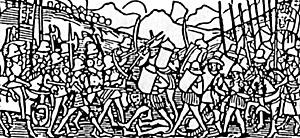 Thanks for sending me a copy of your article "Role
Playing and Matrix Games: Campaigns Made Easy." It's well
written, and it seems to me to be a pretty good recipe for
integrating MGs into RPGs. Of course, I've played a few Matrix
Games and I'm not sure how it would read to person not familiar
with the genre. You might want to send copies to editors of
independant RPG magazines such as White Wolf and see what kind of
response they make.
Thanks for sending me a copy of your article "Role
Playing and Matrix Games: Campaigns Made Easy." It's well
written, and it seems to me to be a pretty good recipe for
integrating MGs into RPGs. Of course, I've played a few Matrix
Games and I'm not sure how it would read to person not familiar
with the genre. You might want to send copies to editors of
independant RPG magazines such as White Wolf and see what kind of
response they make.
I'm including a copy of the basic elements in our Peasant Boy Matrix. We're pretty loose about allowing new elements into the matrix during play, so the story line can go off onto unforeseen tangents. In some ways our style of play is less formal than that I've seen' in the Solidarity game. Our formation of arguments is more semantic, forming sentences, than it is logical, forming rigorous arguments.
When I make a matrix, I take a bunch of 3X5 cards and cut them each into 4 pieces. Thinking about map movement and playing around with these little cards, I came up with an idea for a simple, simultaneous hidden movement system to use in our miniatures campaign. I'll send you a copy as soon as I've got the last major bugs worked out.
Thanks for the effort you put into EGG. I find things in EGG that I can apply in areas of my life other than gaming. I've got a couple of ideas for articles that I'll write as soon as time permits.
CHARACTERS
Peasant Boy
The Outlaws Of The Forest
Evil "King" Ralph's
Chief Counsellor
Peasant Boy's Dog
The Shire Levy
Evil
"King" Ralph's Mercenary Body Guards
The Fair Princess From A
Far Land
The Troubador
Evil "King" Ralph's Robber Baron
Minions
The Old Nobility
A Troll
The Local
Peasants
Evil "King" Ralph
Evil "King" Ralph"s Spy Minions
The Hedge Wizard
Tax Collectors
ACTIONS
Movement (X2)
Negotiation
Treachery
Rousing
Oratory
Abduction
Riot
Oppression By Force Of
Arms
Rumor Mongering
Bribery
Disguise
Ambush
Personal Combat
Open Battle
MOTIVES
Love
Jealousy
Resignation
Loyalty
Anger
Frustration
Gratitude
Hatred
Hunger
Hopeless
Romanticism
Fear
Desperation
Greed
THINGS
The Secret Birth
Taxes
Superstition
Mark of Good
King Henry's Son
The Exchequer
Popular Sentiment
The
Memory Of Good King Henry
The Fair Princess' Large Dowry
PLACES
The King's Castle
The Whole Countryside
A
Bridge
A Tavern
A Forest
A Village
Smellwater
(A Sea Port)
CONSIDERATIONS
Chivalry is Not Dead.
He who fights and runs away lives to fight another
day.
Minions and Mercenaries are expensive.
Feudal Obligation
CONNECTIVES
Yes, and (x2)
Yes, But (x2)
No, actually (x2)
OPTIONAL CONSIDERATIONS FOR MILITARY GAME
 Peasant Boy is a strong fighter.
Peasant Boy is a strong fighter.
The Local Peasants are weak fighters.
The Old Nobility are strong fighters.
The Shire Levy are average fighters.
The Outlaws of the
Forest are average fighters.
The Hedge Wizard is an average
fighter.
Evil "King" Ralph is a strong fighter.
Evil
"King" Ralph's Chief Counsellor is an average fighter.
Evil
"King" Ralph's Mercenary Body Guards are strong fighters.
Evil "King" Ralph's Robber Baron Minions are strong
fighters.
Evil "King" Ralph's Spy Minions are weak
fighters.
Tax Collectors are weak fighters.
Trolls are strong fighters.
I first heard of Steve's game when I saw him in South Bend at the Emperor's Birthday convention. When he recounted the adventures of Peasant Boy (could he also be Farm Boy? with Buttercup, Iniego, and Fezzic?) I knew I wanted to see the game.
Steve says that he runs the game with a more open matrix. It sounds like arguments and argument resolution are done the same as in other MGs. The point of the game seems to be more aimed at having the matrix grow in interesting directions. So each turn, the players make arguments about what they want to have happen. The results of the winning arguments become part of the matrix. Also if the matrix does not have a reason the a player feels "should" be there he can use it. If not one objects to it, it becomes part of the matrix as well. So it is possible to add to the matrix even without winning arguments.
This kind of action adventure MG is fun to play if one does not demand that a game have clear definitions about winning and losing. Players can compete in these games the whole play session but in the end it is very hard to say who the WINNER is.
Action MGs like this can be made to cover almost any adventure setting. Steve has this matrix and does a Baron Munchausen game. Sam Mustafa planned to do a Monty Python-like Viking game. I made a Holy Grail MG and done several prehistoric games. In fact these are probably the simplest MGs to make because they are so tongue in cheek. The matrix does not have to be complete. It just has to be funny.
Back to Experimental Games Group # 11 Table of Contents
Back to Experimental Games Group List of Issues
Back to MagWeb Master Magazine List
© Copyright 1991 by Chris Engle
This article appears in MagWeb (Magazine Web) on the Internet World Wide Web. Other military history articles and gaming articles are available at http://www.magweb.com